#Jon Pertwee my beloved
Explore tagged Tumblr posts
Text









Jon Pertwee as the Third Doctor
July 7th — Happy Birthday to Jon Pertwee, otherwise known as our Third Doctor, who would have been 105 years old today!
#jon pertwee#classic doctor who#third doctor#my doctor ❤️❤️#Jon Pertwee my beloved#happy birthday Jon!!
73 notes
·
View notes
Text
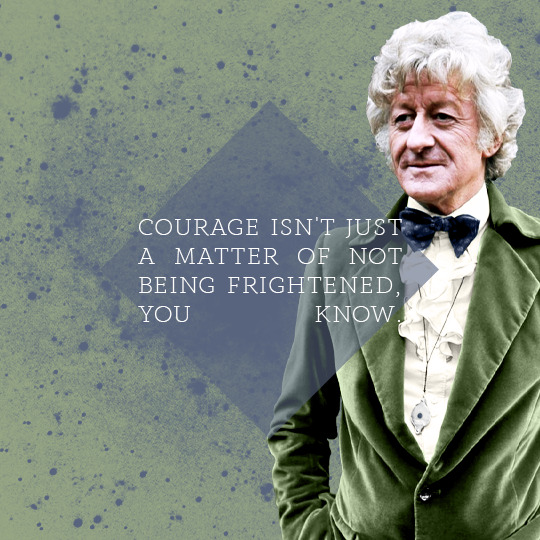
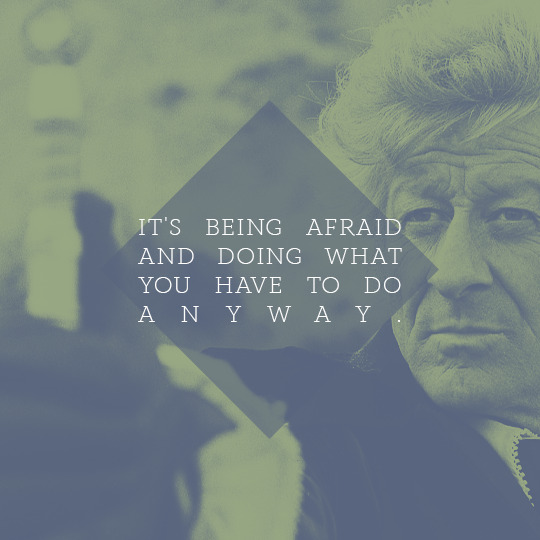
You're serious, aren't you?
About what I do? Yes, not necessarily the way I do it.
#dwedit#doctorwhoedit#doctor who#cdwedit#cwedit#classic doctor who#classic who#classicwhoedit#third doctor#thirddoctoredit#jon pertwee#jonpertweeedit#*mine#*edits#i've been watching/rewatching some three serials over the last few weeks#i've got planet of the spiders up next wahhh#three my beloved i just adore him what a doctor#my favourite classic doctor i think#i cackle every time he says 'hai!' i'm sorry i can't help it#this is very simple but i've never done that text effect before it's pretty cool
323 notes
·
View notes
Text

A most civilished drawing of Jon Pertwee enjoying himself in a hot tub, with a most good humoured pint of wine.
On Friday, me and my dad were outside looking at the animals that somehow came to our garden, such as two meercats and a small brown rabbit who was stuck up our leaves. Soon we heard some thunder. A dark cloud was coming, but not just any dark cloud. It had an orange tint to it, and that meant danger. We went inside, and I was so scared I just had to bathe in a hot tub for a while. The water was cream in colour, and in order to enjoy, I had to adjust the bubbles and the power under 100 - otherwise I'd flood the bathroom. I had to keep Gomez away from the bubbles - I didn't want to damp him, not even stain his precious suit with the gel.
A friend of sister came over as well. We did two things that followed similar rules as the hot tub:
Climb to the top with rock crevices and drawers - you had to watch over how fast you where going and how contorted was your face, or you'd fall down.
Then we raced a bunch of stairways - we had to keep our heartbeats in a tranquil pace or we'd collapse from exhaustion.
After the day was over, mom told sister that the next time she'd see her friend would be in 15 months.
While doing these three things, I put myself into Pertwee 's body in the tub, Tennant in the crevices and Layton in the stairs. Sister's friend chose a nondescript character wearing some pink and dark brown.
But for this occasion...I drew Pertwee's scene. He also wore a bathrobe.
And may I remind you - this is a dream I had. I guess you can tell with how nonsensical and incoherant I made this story.
Hope you like it!
Artwork (c) CreativeCuquiLu
#jon fucking pertwee my absolute fucking beloved#(after john astin of course)#dream#storytime#hot tub#jon pertwee#wine#sexy time!#bubbles#fancy#enjoyment
3 notes
·
View notes
Text

FINALLY! 😍 It's finally been released on this side of the ocean!
#doctor who#third doctor#jon pertwee#the pain of being a non-uk whovian#i was listening to Prisoners of the Lake when it arrived so I'm even more in the mood for this era 😀#really happy I've been waiting for it for ages☺️#unit family my beloved#three#I pre-ordered it in January and we're in July 🥶🥵
3 notes
·
View notes
Text
*Cough* The Third Doctor and The Master *Cough*
I don't care what you say about the 60th anniversary specials. David Tennant's Doctor has never been fruitier than whatever the hell he was doing in Utopia. The way he looks at Professor Yana? Whatever the hell kind of vibes he was putting off in his conversation with Jack in the radiation chamber? Ignoring the two people who currently fancy you in exchange for looking near-worshipfully at your evil ex in human form because he embodies hope? Telling your other ex that you can't stand to look at him because he's wrong yet being more honest with him than you have anyone else for a long, long time? Unhinged queer icon. Who needs healthy admissions of feeling when you have whatever the hell kind of subtext-rising-to-text these two moments are conveying
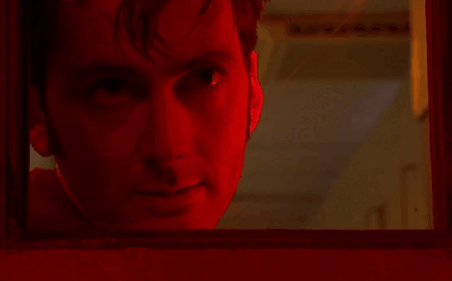
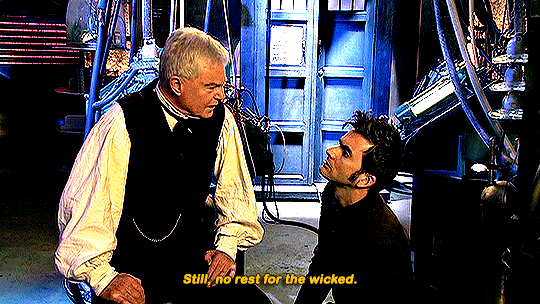
#tenjack#thoschei#professor yana#jacobi!master#tenth doctor#utopia my beloved#the acting choices went off this episode#everyone is firing on all cylinders#derek jacobi#jack harkness#the third doctor#the master#jon pertwee
2K notes
·
View notes
Text


I DIDNT DO ANYTHING BECAUSE THERE WASNT MUCH TIME & I AM SOOOOOOOO DRAINED TODAY BUT BEFORE MIDNIGHT STRIKES . happy two year anniversay to me and paul henderson ;w; my very first ever exposure to jon pertwee i love paul henderson sooooooo dearly.
my beautiful beloved actor boy hes so lovely
7 notes
·
View notes
Text

For Throwback Thursday, here's a piece I wrote about my beloved classic Doctor Who, and my top favorite Doc of all time, the great Jon Pertwee!
https://retrorevelations.blogspot.com/2017/11/for-love-of-jon-pertwee-why-third.html
#retro revelations#doctor who#jon pertwee#third doctor#roger delgado#the master#unit#daleks#sea devils#inferno#lethbridge-stewart#jo grant#liz shaw#sarah jane smith#mike yates#sergeant benton#peladon#70s#GOAT#sci fi#science fiction#BBC#throwback thursday
7 notes
·
View notes
Text
Reasons I love the Spymaster #80: Sacha Dhawan takes him seriously!
Find my full series under the HELP I WUVS HIM tag.
#80: Sacha Dhawan takes him seriously!
The role of the Master is usually played broadly. The performer alternates between periods of actual menace, gleefully evil generation of complicated plot, comic relief, and momentary poignancy. The character is often charming, charismatic, attractive, sometimes likeable and understandable. However, as a character without a lot of screen time, the Master does not usually have a highly developed subjectivity and emotional life.
All performers of the Master seize on the role as a chance to have fun and to chew scenery. All performers have also endowed the character with something beyond that, thanks to their particular performances. For one example, Roger Delgado's real-life friendship with Jon Pertwee spills over into the relationship between Delgado Master and Three, coloring it with a familiar camaraderie of longtime partners.
For example, check out the moment in The Sea Devils when the Master is pretending that he has repented. Jon and Roger are very clearly smirking throughout the entire scene, which gives the impression that the characters are fondly teasing each other.





For another example, Michelle Gomez's super campy performance of femininity emphasizes that gender is a choice for Time Dorks, which makes them rather genderqueer.
And all performers of the Master have enriched and developed the character in various ways, but none quite like Sacha Dhawan with the Spymaster.
He's playing the role broadly, of course, but he also grounds his performance in a methodical consideration of the character's motivations, thoughts, and feelings and how those color everything the character does. For just one small example, see #67: Sacha Dhawan adds unscripted character notes! He's taking the character seriously as a coherent personality in a way that previous performers haven't.
I theorize that Sacha Dhawan's portrayal of the Spymaster's thoughts and feelings is so strong in part because he plays the Spymaster as a person who runs on anxiety, doubt, and depression. He himself has personal experience with those things [see my discussion of the relationship between his mental health problems and his performance as the Spymaster]. So he draws on his personal experience to give convincing specificity to the Spymaster's manifestations of mental turmoil.
In #72: All his disguises are transparent!, I quote Sacha Dhawan as saying that he gets "real joy" from playing the Master by "constantly taking the strands and reinventing them," "as long as it's truthful." Maybe some of his joy comes from being able to use his own unhappy encounters with anxiety and mental health problems to create a complex, truthful performance of a character acclaimed by critics and beloved by fans.
@natalunasans @sclfmastery @timeladyjamie @whovianuncle @rowanthestrange
#HELP I WUVS HIM#sacha dhawan#the spymaster#the master#depression#anxiety#mental illness#drawing on personal experience for a performance#making it look TRUE#the joy of making things true#doctor who#the sea devils#delgado master#the jon and roger show#roger delgado#Roger Delgado's eyebrows
26 notes
·
View notes
Text
Doctor: Now hold this. If it's infinitesimally low, we'll miss it entirely and goes whistling off to heaven knows where. But if it's too high, even by a fraction of a moment, whumph! Time ram.
Jo: Time ram?
Doctor: Yes. You see, the atoms making up this Tardis would occupy precisely the same space and time as the atoms making up the Master's Tardis.
Jo: But that's impossible!
Doctor: Yes, well of course it is. So what do you think would happen?
Jo: Whumph!
Doctor: Yes, exactly. Extinction. Utter annihilation. Now do you still want to come?
Jo: It is my job, remember?
Doctor: Glad to have you aboard, Miss Grant.
Jo: Glad to be aboard, Doctor!
#i love their dynamic#so much#classic who#doctor who#third doctor#jon pertwee#jo grant#my beloved#the time monster
31 notes
·
View notes
Text
The Shared Dalek Universe of the 1960s: A Case Study
In 2011 (a little over ten years ago!), El Sandifer cited my dearly-beloved 1960s Who Annuals as examples of stories which ended up influencing the TV series many years down the line despite making an unrepentant hash of continuity.
Her first example is that the Doctor is called Dr. Who, and that he alternates between being from Earth on one page, and not being from Earth three pages later. I would point out that TV was doing much the same thing in those days, and went on flip-flopping basically until Jon Pertwee, so it’s not a terribly good argument to begin with.
However, she spends more time pondering the Daleks of the comics. These Daleks, she notes, are very different from those on television at the time. There are hordes of them, they travel in fleets of saucers, and they’re ruled by the Emperor. This contradiction, she argues, later fed back into the TV series in the RTD era, when huge fleets of Daleks became the norm and, earlier but still well after the first burst of Annuals, in the form of Patrick Troughton facing a very different Dalek Emperor in The Evil of the Daleks.
In no way do I wish to undermine Sandifer’s ultimate conclusion that “canon” in the sense of diegetic consistency is a red herring of little importance, and what matters for any sane definition of ‘canon’ is whether a story is referenced at all, not whether it’s contradicted.
However.
Having gone back to 1966′s The Dalek Outer Space Book, I have made a very startling discovery, in the story entitled The Secret of the Emperor. The rest is after the cut; I will leave you with a delightful panel from this story, showing the “bewildered” Dalek Emperor being bullied by knights at the Battle of Agincourt. (This is one of my favourite Doctor Who images ever, and if it doesn’t put a smile on your face I am not sure I want to take you seriously.)
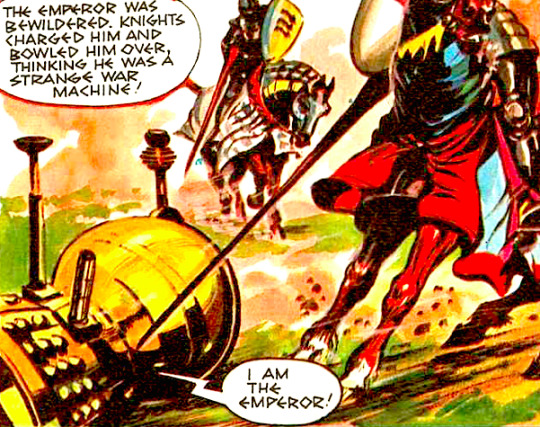
So, famously, when he debuted in the comics, the Dalek Emperor was not the giant, static Dalek later shown on television in The Evil of the Daleks and The Bad Wolf of the Ways; instead, he was golden, squat, and had a bulbous head; to house all the ego, one expects.
Thus, most people will point at the fact that when the Doctor met “the Emperor” in The Evil of the Daleks, he resided in a huge tower-like casing in the Dalek City, as evidence that although ideas received a first treatment in the comics which later made it to screens, no direct continuity was intended; the comics’ Emperor was an alternate, a first draft, to be discarded once a more definitive TV portrayal emerged.
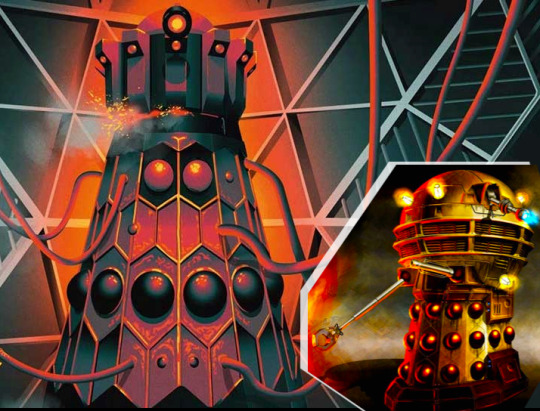
And yet, of course, it is somehow appealing to think of the two as the same Dalek, isn’t it? John Peel (Dalek writer voted most likely to be a 19th century Victorian man who stumbled into a time eddy; it’s mostly the remarkable sideburns) spent a lot of time in his Dalek novels establishing the life story of the Dalek Prime, the First Dalek Ever, who transitioned from the globe-headed casing to the towery Evil one and then deeply regretted it, what with the “getting killed by his own infighting troops with no way to escape”.
But this is usually viewed as a retcon. A cute retcon, an admirable retcon even, but a retcon. My good friend and esteemed fellow canon-welder, @rassilon-imprimatur, espoused such a view four years ago:

Well, all of this is, if you’ll pardon my French, bollocks. John Peel didn’t make anything up, except for the snappy name of “the Dalek Prime” as a designation for the individual. The Dalek Emperor in Evil of the Daleks was always the Emperor of the 1960s comics, and there is a very good reason for his seemingly-contradictory change of appearance. What’s more, I am not talking about murky authorial intent: these are things that the discerning Dalek fan in 1967 was meant to have known.
Let me wind back the clock to 1966. A Dalek master-plan is unfurling, a multi-media agenda spanning several years, more ambitious perhaps than even Time Lord Victorious in its scope; for the ultimate aim of a small cabal of men including David Whitaker, Terry Nation and Brad Ashton is nothing less than spinning the Daleks out of Doctor Who and into their own non-BBC TV show — to be made in America, and in colour, if you please!
For over a year now, a Dalek story arc has been running in the pages of TV Century 21, tracking the early rise of the Dalek Empire and its early interactions with 2060s humanity. Though the Daleks encroach over other parts of the book, including the headline stories, the bulk of this story arc comes in the form of weekly one-page comics making up one long serialised history of the Daleks, under the minimalist title of The Daleks.

Also under the solo brand of “The Daleks”: Annuals, an exclusive audio story, and, of course, toys. Time for Phase Two. It is time to end the Daleks’ endless confrontations with Dr Who on television, and set the stage for a new status quo able to support the TV series Nation dreams about.
Important background: Terry Nation, famously, does not like the Dalek Emperor. Whitaker made him up without consulting Nation, who maintains that the highest rank in the Dalek hierarchy should be the Dalek Supreme. The Emperor was hard to do away with in the comics, since he was basically the protagonist of the TV21 strip, but one imagines Nation was keen to jettison him from the world of the planned TV series.
I am speculating, of course, but I picture Nation sitting in his office, pondering the two great thorns in the side of the Independant Daleks Masterplan.
Thorn one: the Daleks are entangled with the Doctor both diegetically and symbolically; unless something can be done, the Daleks will remain “the Doctor’s enemies”, and a show where they commit evil and the Doctor fails to show up would ring false with the kids watching. The Daleks must be removed from Doctor Who in a sensational and definitive manner, or the whole enterprise is a nonstarter.
Thorn two: I, Terry Nation, have foolishly allowed David Whitaker to shape the lore of the Daleks, and he has made this Dalek Emperor guy very central to early Dalek history, leading up to the 22nd century Dalek Invasion of Earth that most of the Doctor’s subsequent conflicts with the Daleks have stemmed from. But I do not like the Dalek Emperor. I wish I could get rid of him in my new status quo.
…………Aha.
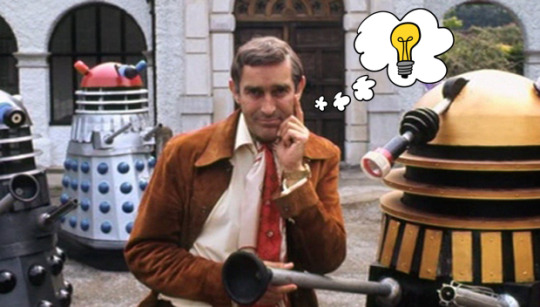
A triumphant Terry Nation adds a post-it note to the ever-widening corkboard representing the multimedia Dalek Masterplan setting up the TV series, which must already include things like “convince Jean Marsh to come back as Sara Kingdom”. Notes distilled from this corkboard will form the backbone of The Dalek Outer Space Book, this year’s Dalek annual, which exists principally to set up the prospective main characters of the new TV series: Sara Kingdom and Agent Mark Seven, of the Space Security Service.
The new post-it note reads:
Construe the Daleks’ enmity with the Doctor as a personal enmity between the Doctor and the Emperor, a la Sherlock Holmes and Moriarty. Have the Doctor triumph over the Emperor on TV in a big ‘event’ story.
Result: the Doctor-vs-Daleks storyline is over; the Emperor is dead; I get everything I ever wanted.
(Except maybe a pony.)
Then he phones David Whitaker, smirking all the while like an evil genie preparing to grant a badly-worded wish.
“Good news, old chap, I’ve decided you can write a new Dalek story for the BBC, all by yourself. I promise I won’t interfere.”
*confused and delighted David Whitaker noises*
“ And you can even bring in that Dalek Emperor of yours. Yes, you heard me!”
*Whitaker enthusiasm intensifies*
“Ahhh, but there’s a catch. The Dalek Emperor must DIE.”
Of course, like all good Faustian bargains, this is irresistible even though it is ruinous and the victim knows it to be ruinous. Whitaker agrees to the scheme. He and Nation begin planning out the events of the great finale of the Dalek-Doctor confrontation, which will hit the screens in 1967 as the mildly racist, but otherwise quite well-loved, ‘The Evil of the Daleks’.
Quickly enough, it is decided that Patrick Troughton crouching to berate the short and bubble-headed Golden Emperor would look silly. If the Emperor appears on TV, alongside human performers, then it should tower over them. Besides, this is to be the archvillainous Dalek Emperor’s last stand, and certain traditions must be followed.
Hence another task is added to the bucketlist of the Dalek Outer Space Book: tell the story of how the Emperor transformed from the globe-headed dwarf to some huge and terrible towering form under the Dalek City, for the Doctor to stumble onto later. This rebuilt Emperor may be teased, but must not be truly seen or truly defeated in the book; that would defeat the whole idea.
Hence, The Secret of the Emperor, a story which sees the Emperor becoming self-conscious about his own efficiency and letting the Scientist Daleks rebuild his casing from scratch. The final page is a splash panel, a delightfully nonsensical diagram of the mechanical components of the new casing.

The almost surreal array of colours and shapes is so arresting as to obscure an important detai. Many have seen this page over and over, and yet still missed it. The recent(ish) ‘Anatomy of the New Dalek Emperor’ artwork from Time Lord Victorious clearly looked at this page for reference, in spite of the fact that the TLV Emperor is much more inspired by the old Emperor than the rebuilt one.
Let me spell it out for you: look at the Scientist Daleks in the top right and centre-left. Look at them.
The new Emperor is huge.
And what else?
That Scientist on the left is plugging huge wires snaking from the wall into the tower-casing.
He now resides in the Great Hall of the Dalek City.
The background wall is a weird checkered pattern.
In addition, the following facts are seeded throughout the earlier pages of The Secret of the Emperor.
The point of moving to the new casing was to grant the Emperor increased brain capacity (suitable for concocting masterplans).
He acquired said increased brain capacity to help the Daleks attempt to overcome humanity once and for all.
The Emperor has recently had a trautmatic but eye-opening experience with time travel.
Ignore the fact that the Emperor was here depicted with what appears to be a still fairly bulbous, and golden, head, and it doesn’t take a genius to figure out that this is very, very direct setup for how the Doctor finds the Dalek Emperor in The Evil of the Daleks — tower-like, in an imperial throneroom in the Dalek City, with a checkered wall pattern, planning out a complicated scheme to harness time travel as a means of defeating humanity once and for all!
Yes, the designs don’t quite match — but how could the artist behind the visuals of Secret of the Emperor have known precisely what Shawcraft would build, a year later, based on the same basic description by Nation & Whitaker? The parallels far outweigh the minor differences in execution. (It’s worth noting that elsewhere in the Outer Space Book a different artist drew what was clearly intended to be the Golden Emperor as a large, golden, but normally-proportioned Dalek, so it’s not like the visual descriptions of these scripts were exceedingly precise…)
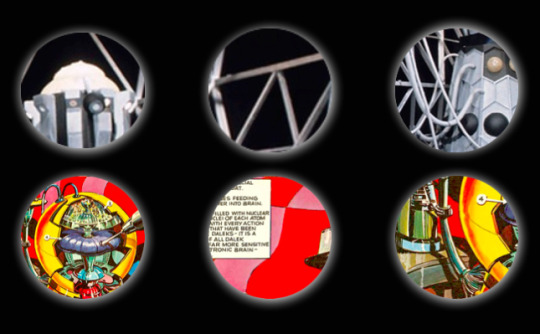
The rebuilt Emperor is never seen in the Outer Space Book outside of this ‘dissection’: he is heard throughout The Brain Tappers but kept carefully off-panel, and his new and dangerous new casing is pointedly not destroyed in the story’s conclusion. Well, of course not. That’s what Dr Who is for.
tl;dr: it is not a post hoc retcon, or even a secret, that the round-headed Emperor of the comics became the Dalek Emperor of Evil of the Daleks. A holistic view of the state of Dalek media in 1966-1967 shows that, in fact, it was the whole point that this be the Emperor of the comics; and that the comics had begun setting this up long before Patrick Troughton encountered Edward Waterfield on TV.
And thus, to circle back to Sandifer’s 2011 post, it is not enough to simply say that the “seemingly non-canon” comics inspired the show down the line. In fact in this instance, what appeared on Doctor Who existed for the benefit of the Daleks spin-off — not vice-versa!
#Daleks#Canon-Welding#Doctor Who#Analysis#Doctor Who Meta#Dalek Emperor#Dalek Prime#The Evil of the Daleks#Terry Nation#David Whitaker#Brad Ashton#The Secret of the Emperor#El Sandifer#Canon#Jacob Black
76 notes
·
View notes
Text
Rewatching the Silurians tonight and it’s been a while. I completely forgot about this absolutely adorable exchange between Liz and the Doctor!
#classic doctor who#third doctor#liz shaw#doctor who and the silurians#I wish we had more time with Liz these two were so much fun together!#first of all the KISS!!! he kisses Bessie!!#and that little chuckle is killing me that loudest squeak I let out when I heard it#he’s so so precious everyone look at my Doctor#Jon Pertwee my beloved
48 notes
·
View notes
Text
Okay so I wouldn’t spend the money that fan conventions….especially Creation but I use to love going to cons back in the 80s and 90s. Below are my top 10 favorite actors I got to see, and these aren’t in a particular order.
#10 Tom Baker
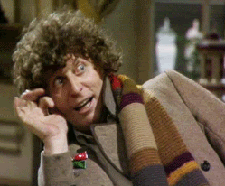
The man may be a little eccentric, but he is fun to listen to on subjects that really matter to him. I remember I gave him a rose (versus the Dr. Who toys others had for him) at the meet and greet which was a very fast-moving line and he smiled at me and literally began talking to me about his garden. I swear if the handler wasn’t there to move the line along, he would have continued the conversation because he was genuinely so happy to discuss his love of gardening.
# 9 Jon Pertwee
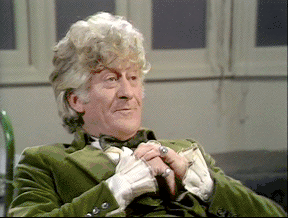
Yup there are several original Dr. Who(s) on this list. This man was truly fascinating and definitely what you would call a renaissance man. He didn’t discuss it, but I would have loved to hear him discuss his military service during WW2 and if you’re not familiar with his military service here’s a link for
# 8 Peter Davison

Heh I got to see Peter Davison while he was still the Doctor(I think his last episodes aired in the UK at the time) and honestly he was so different than Tom Baker and Jon Pertwee. The other two men were both very funny but still a little more reserved and formal. Peter Davison not so much.
Oh, my he has a wicked sense of humor, casual and had a little more ‘no hold barred’ attitude. He had no problem talking about the problem the first two seasons of Dr. Who that he did and that they seemed to have waited until his last season to give him some decent stories (which I completely agreed with).
# 7 Rick Baker

I have to admit I went to his panel because it was sweltering out and the AC in the convention sellers area wasn’t working so we went into the hall and heard some laughter coming from one of the smaller rooms. We poked our heads in it was blissfully cool so we decided to sit in on the panel.
There weren’t many people in the room, so it was actually kind of informal but seriously this man was fascinating. His love of special effects make up was inspiring and Mr. Baker was also one of the more charming and delightful speakers I’ve ever seen.
I still think American Werewolf in London had amazing special effect make up.

# 6 Jonathan Frakes

I saw him in 1993 and he was so funny from the moment he came out to What a Man by Salt N Pepper to jokingly calling Deep Space Nine Deep Throat Nine.
I wish I could remember more but seriously the man could do stand up, I never stopped laughing during his whole panel.
# 5 John de Lancie
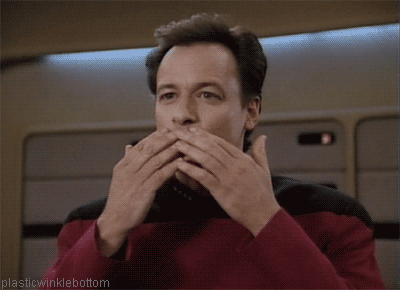
A true renaissance man. He isn’t for everyone, and I don’t agree with everything he says but he didn’t shy away from controversial topics, and I respect his intelligent and thoughtful responses. I was always a little surprised he never ran for public office.
# 4 Janet Fielding
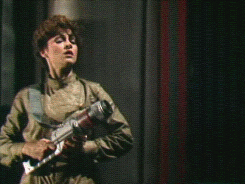
I always felt bad for Ms. Fielding because she was one of the companions that fans didn’t warm up to.
There was a point back in those days after Elizabeth Sladen left that fans compared the other companions to Sarah Jane which was so hard because she was such a beloved character.
Plus Ms. Fielding definitely dealt with some pretty obvious sexual harassment on and off set but she was also so sweet to the fans even when they would repeatedly ask about her ‘boob tube’ costume.
Seriously I still can’t believe how professional she was. The woman is just a class act…unfortunately can’t say the same for a couple of her costars and the pervy fans she dealt with.
# 3 Nichelle Nichols

There are few people I would say left me completely star struck, and meeting Nichelle Nichols was it.
I know she is hailed as an inspiration for young African Americans girls in the sixties (and obviously she was) but she was an inspiration to all young girls in the 60s and 70s and I wish people would say that more.
I grew up in the 70s where the female role models on TV were housewives or if they were working women they were normally nurses or teachers. There were a few female cops or military officers.
She was the woman who could do what she wanted and as far as we were concerned she was equal to her male counterparts on the show.
Plus, when she spoke about the point, she thought about leaving the show and Dr. King spoke to her sent literal chills down my spine. I have to post this part from her biography where she spoke about the encounter:
“You cannot and you must not,” she recalls him saying. “Don’t you realize how important your presence, your character is? ... Don’t you see? This is not a Black role, and this is not a female role. You have the first non stereotypical role on television, male or female. You have broken ground.
“... For the first time,” he continued, “the world sees us as we should be seen, as equals, as intelligent people — as we should be.”
I still feel blessed to have met this amazing woman!
#2 Paul Darrow, Michael Keating, Mark Ryan, and Michael Praed

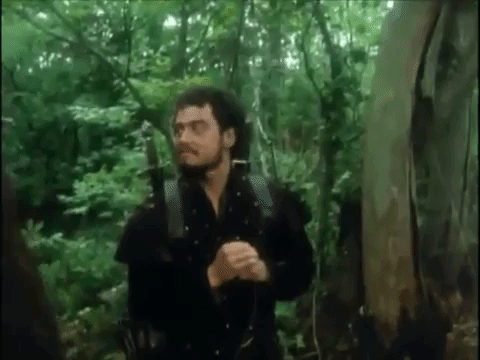
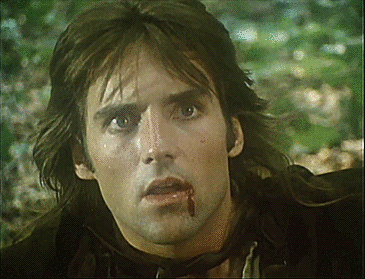
I know that’s four people, but I went to a small Blake's 7 and Robin of Sherwood con twice back in the 80s and these four men were just the bomb.
They were all laid back and the con was in hotel where there wasn’t much around, so you pretty much spent the whole time inside and these men hung with the fans.
You would go to the restaurant for breakfast and if they came in they would stop by your table to say hello, ask if you were having fun. If you were in the bar they would sit down and have a drink with the fans.
Security…what’s that…this con I swear didn’t have any and the wranglers were only around during actual events to keep things moving. Free time nobody told you to give the guests space…hell they sought the fans out and hung out with us. Just the chilliest con I ever went to.
Actually, the first time i went Michael Praed wasn’t a guest but the next year he came, and I believe him when he said he came because Mark Ryan told him what a blast the con was.
Oh, and when he did the con, he was still on the original Dynasty which average about 20 million viewers an episode. So seriously an all-around awesome guy who was completely down to earth.
# 1 William Shatner

Yup Captain Kirk!!! My nieces husbands are both Trekkies and think I’m the bomb because I got to see everyone from the original show (except Leonard Nimoy sadly) and I swear their mouths dropped open when I told them I saw Shatner.
Bill Shatner just makes me giggle like a schoolgirl. I will say he is definitely someone who has his tongue firmly planted in his cheek when it comes to mocking himself.
Hell, he’s had a second career playing up this and did some of his best work. Watch Boston Legal if you don’t believe me. Him and James Spader were wonderful together.
And yes, I know he's not politically correct, but I don't care...he's CAPTAIN KIRK.
#fan convention#creation con#tom baker#jon pertwee#peter davison#rick baker#jonathan frakes#john de lancie#janet fielding#nichelle nichols#paul darrow#michael keating#mark ryan#michael praed#william shatner#dr. who#star trek the original series#star trek#star trek new generation#blake's 7#robin of sherwood#american werewolf in london
6 notes
·
View notes
Photo










Yes, guys. I prompted Worzel into Dalle.
I literally just looked away after these generated, so if anything feels wrong, just feel free to report me, splash some drops of holy water onto my face or simply, set me on fire.
Hope you don’t like them!
#dalle#shitpost#meme#ai generated#worzel gummidge#jon pertwee#(jon f🐦king pertwee my beloved)#(my hearts robins nest and grandfather's clock got out to you babe)#cursed#scarecrow#the scarecrow of oz#wizard of oz#the scarecrow of scatterbrook#trail cam#the backrooms#gta iv#wicked witch#dorothy#hug#interrogation#gandalf#guy fawkes night#bonfire night#sparklers#tom baker#corn maze#pursue#bunnies#kissing#radagast the brown
1 note
·
View note
Text
Arrr is for Run-of-the-mill

In a recent interview with the Radio Times, outbound Doctor Who showrunner, Chris Chibnall, stated that he expects Russell T Davies will ignore the changes he made while showrunner. According to Chibnall- “every era contains a contradiction or left-turn from what has come before.” Like when Moffat completely ignored the regeneration limit or the destruction of Gallifrey. Ignore the fact that in doing so, he also took into account the War Doctor and two Tenth Doctor regenerations, effectively making the Eleventh Doctor the Thirteenth Doctor. Or that the War Doctor and his future selves reversed the outcome of the Time War. Steven Moffat didn’t simply ignore what came before, he wrote something that worked within the parameters of the show. You know, like a writer.
It’s odd then that Chibnall should find himself on his second to last episode following a time-honoured tradition in Doctor Who reaching back as far as 1972. That tradition being the making of a Doctor Who story starring the Sea Devils that isn’t very interesting. Because let’s be honest, this isn’t exactly a sacred baddie. To the best of my knowledge, what most anyone likes about the Sea Devils is how they look. The sympathetic redesign of the Sea Devils leaves nothing to be desired, they look great. The good news is that the Sea Devils are no worse off than they were at the end of 1984’s “Warriors of the Deep.” The bad news is, there’s very little worth mentioning about “Legend of the Sea Devils.”
From the outside, this episode should be a winner. A beloved classic villain making its return for the first time in the new series, with pirates nonetheless! The problem here is that, much like the Sea Devils, Doctor Who has never really done a decent pirate episode before. If “Our Flag Means Death,” has proven nothing else, it’s that the pirating world is still rife with possibilities. Yet on Doctor Who, they always seem to fizzle (except “Enlightenment,” which owns ass, and I will not take questions). The pirates never feel particularly campy in this or even “The Curse of the Black Spot.” When you hear about the Doctor on a pirate ship, you want to get terrible dialogue and ridiculous set pieces. What we got instead were terrible dialogue and ridiculous set pieces. But you know, not like that.
Doctor Who has swashbuckling in its blood. Just look at Jon Pertwee or Tom Baker. David Tennant riding through a mirror on the back of a horse in front of the entire French court is as dashing as any pirate. The Doctor is a penniless explorer in a stolen ship crewed by wayward souls. She’s rubbed shoulders with the Corsair and fenced with a spoon. So why does this suck so hard? Probably the pacing, the writing, the plot, the structure, and the everything. I’ve said in the past that all I really wanted from Chibnall’s remaining episodes is that he fly under the radar, and boy howdy did he deliver. It would have been nice to expect some big dumb fun, but what we got was closer to big dumb boredom.

Right away you know something is off because everyone is stupid and vague. We meet “Madam Ching,” the pirate Queen of 1807. We don’t really get the giant obnoxious letters telling the location like we normally get, just the year. A father and son argue about stopping Madam Ching who is currently banging a MacGuffin dagger against a MacGuffin statue of a Sea Devil. It’s no question to the audience as to what is about to happen. The giant statue looks almost too big to be a Sea Devil, which is driven home all the more by the presence of a human figure in the grasp of the creature’s scaly fist. If this creature was frozen into a statue, was the human figure as well? Why didn’t they also emerge from the statue? Why were they so small? Was the Sea Devil killing a child? Did the child not survive the carbonite freezing process? Maybe someone added it later to make the creature more terrifying to ward off potential idiots like Madam Ching.

The entire scene plays out in the dumbest way possible. An older man, Ying Wai, tells his son, Ying Ki, to take over guarding the statue in case he dies. Ying Wai promptly goes off and dies. The Sea Devil, known as Marsisuss strikes him down. The magnetic whathaveyou of Marsisuss being freed pulls the TARDIS off course and draws the Doctor toward the action via her earring. Then, as if lying in wait, a floating pirate ship equipped with floaty green bits emerges from the sea, piloted by Sea Devils. What they had been doing in all that time is anyone’s guess. You would think that if your captain doesn’t reappear for about 300 years, the first mate might take command, eventually. It’s like Marsisuss left the car running with the window cracked and his kids are still waiting for him to return from the bank.

What may have been more illustrative, or even more engaging is perhaps Marsisuss needs to first awaken his troops from the sea. Maybe he needs to blow a conch that signals the reviving process and the Doctor tries to stop him. Instead the ship merely appears in the sky like Bowser’s airship. I say this not just because the ships are similar, but that they both have about as much setup. Despite the abrupt and unlikely appearance of Marsisuss’ getaway ride, it does at least look cool. Up to that point, the special effects had been somewhat lacking, so much so that my wife spent the first five minutes marvelling at how bad everything looked. But I honestly don’t mind when Doctor Who looks a bit naff. Like Nintendo, it’s not about the graphics. You want Playstation 5 quality, go watch The Madalorian. I knew the score though, they were saving most of the effects budget for the Sea Devils and their giant sea monster. It’s pretty standard filmmaking, that. Save the money for the important stuff.
There’s a sort of parallel between the Doctor and Madam Ching. Both are famous women travellers piloting a ship by themselves, which actually should be piloted by an entire crew. The parallel is strained by the fact that Madam Ching is so much better a solo pilot than the Doctor. It’s not a question of skill, but a mere observation of facts. We’ve all seen sail barges in movies. You don’t keep a ship crew for the company, these men all have jobs! No matter how much tenacity one woman may have, nobody could sail such a ship alone. If she is on the hunt for the Legendary Ji-Hun’s sunken treasure, she would need a crew to operate a bottom trawler. We’ve all seen these movies and read these stories. We’ve heard “Raise the flag and hoist the mainsail!” time and time again, so it rings hollow when we see something so physically impossible. It’s like Mr Plinkett says- “You might not have noticed, but your brain did.”
The Doctor and Yaz go off to have a bit of lesbian processing while Dan and his new friend Ying Ki are caught spying by Madam Ching. The Doctor’s plan is to go to the point where the treasure was lost at sea and rescue it before it falls to the bottom of the ocean, even though the Doctor illustrates that the TARDIS can actually sit at the bottom of the ocean with an air bubble protecting them. While back in time, aboard Ji-Hun’s ship, we see Ji-Hun forcing his men overboard and pledging allegiance to Marsisuss. The ship never actually sank, but was rather taken over by the Sea Devils and decked out with green floaty bits. They must have been proud of this visual because they give the ship three big reveals. It’s like “Star Trek: The Motion Picture,” in here. The Doctror and Yaz abscond back to the TARDIS just as a fight breaks out between Ji-Hun and Marsisuss. Landing at the bottom of the ocean, the Doctor finds no sign of sunken wreckage. Using the Little Mermaid ambience, the Doctor chooses this as the moment to flirt with Yaz a little.

At this moment, the ground begins to open and a giant sea monster emerges and captures the TARDIS within its mighty jaws. If only that thing could dematerialise. Luckily, this sea monster is no more than a glorified lift. I half expected a Flintstones gag where monster looks at the camera and says “Eh, it’s a living.” This wouldn’t be the first time Chris Chibnall has taken a big concept and reduced it to a means of safe transportation for the Doctor. They did that with the Weeping Angels too. It’s the worst kind of consistency. Set up without exploration. Your giant monster isn’t even a giant monster, it’s an elevator. Whatever.

Aboard the Sea Devil vessel, the Doctor and Yaz see Ji-Hun, still alive, but kept prisoner in a Tim Shaw type of thing. My guess is that Marsisuss must have been fully conscious while trapped in that statue. It’s the only reason I can think that he would just spill the beans of his entire plan to the Doctor. He was desperate for a bit of banter. His basic plan is to use something called the keystone, which is yet again, another MacGuffin to flood the earth using magnetism or some such nonsense. Ignoring the fact that there’s not enough water to flood the earth, what would be the point? Water covers over 70% of the Earth. Bro, you’ve already won. If you can’t control the planet from the majority of its surface, another 30% isn’t going to help. Maybe you’re dumb and your plan is dumb and you’re a bad leader. Your crew didn’t even know how to appoint a new captain. You’ve given them no guidance on what to do in your absence, so of course, you’re losing.

After realising the Doctor doesn’t know where the keystone is, Marsisuss decides it’s time for her to die. Before he can cut her down, the Doctor pulls a big switch that sends the ship to the surface of the water. During this time, we’re expected to believe that the ship resurfacing is enough of a distraction that Yaz and the Doctor are able to escape unscathed. Somehow, they are able to gain their bearings faster than the guy who actually knows the ship, and are able to swing from ropes to the safety of Madam Ching’s boat. It’s like when Yaz and Dan witness the Weeping Angels killing two old people and then are perfectly fine in the next scene. It’s almost as if they hope that if they throw this crap at you fast enough, you won’t have time to think about how stupid any of it was.
What comes next is arguably the best part of the episode. Finally, some actual swashbuckling! For a brief moment, the story remembers this is a pirate episode and we get some actual swordfighting. The Doctor even gets in on the action, which is great to see. In fact, Jodie Whittaker is on her A-game for this story. Unfortunately for her, the writers, Ella Road and Chris Chibnall were not. I feel sorry for Ella Road because so many of Chibnall’s deficiencies are on display here, that it feels unfair that she must shoulder the blame. We get the Doctor’s weird morality in the form of disgust that Ji-Hun may want to avenge his crew by cutting down Marsisuss. I say weird in that just moments later we see Dan cut down seven Sea Devils in two blows like he was straight from Grimm’s Fairy Tales.

Even worse than that is the moment where the Doctor lets Ji-Hun die in her place. Evidently, he deserves to die because he killed the guy who imprisoned him for 300 years. It’s as though Chris Chibnall took none of the criticism from “The Timeless Children,” to heart. The Doctor, who once gave one of her lives to save a companion she’d only just met, allows men to die as doorstops. Their sacrifice affording her a coward’s exit every time. When Steven Moffat received criticism for his writing, you would often see a meta commentary within the show, as if it were Moffat’s way of addressing the issues. There was a conversation going on. Here you see a cowardly writer writing a cowardly Doctor and refusing to admit any wrongdoing. I feel as though any restraint shown by Chris Chibnall at the end of Flux was more of a dictate from above, than any kind of re-direction. It feels petulant and selfish. The only way to redeem this kind of cowardice would be for it to be how the Doctor dies.

Speaking of the Doctor’s death, we get a bit of a glimpse into the future with the Doctor mentioning she promised Yaz a beach. I can’t help but feel this is foreshadowing of the Doctor regenerating on a beach. It’s already been established that the Doctor will not be regenerating aboard the TARDIS. The cynic (or realist who has eyes and has been writing about this shit for four years) in me thinks this is probably going to be some weaksauce attempt to recapture the emotion of Ten and Rose’s teary goodbye at Bad Wolf Bay. Only this time, instead of an established romance, you’ll get the tacked on gay tragedy of Thirteen and Yaz. And I don’t care if you’ve been shipping Thasmin since day one, the relationship has been all in your imagination. Even Chibnall admitted it wasn’t a planned storyline.
As you would expect from an unplanned storyline, the Doctor and Yaz’s romance subplot comes out of nowhere, gets barely explored and is gone immediately. It’s exactly what I’ve come to expect from Chris Chibnall- an idea is presented, they talk about it, nothing happens. That isn’t to say that either Whittaker or Gill do a bad job in this scene. There is a part of me that really enjoyed the Doctor finally saying out loud why she doesn’t do romance. Though you could also argue that it never really needed saying. We already knew it. But I guess Yaz needed to hear it, because the poor girl is about to pop. At this point, all they’ve done is made an argument for the healing power of a quickie.
All in all, I place this episode as the third in a sort of spiritual trilogy of Chibnall episodes. Right alongside “Dinosaurs on a Spaceship,” and “Arachnids in the UK.” The central theme being that the premises of all three episodes promise big fun, and somehow manage to bore me out of my mind. Not everything was a disappointment, however. The Sea Devils looked great and I loved the costuming. The Sea Devil’s swords reminded me of the knives people make from bismuth on Youtube. It’s a cool way to make something look more natural while still other-worldly. I loved seeing the Doctor do a bit of action and drama. But the characters are so ill defined that I found it difficult care about anyone or anything. Madam Ching is a cool pirate, but other than that, she’s giving me nothing to work with. So when she and Ying Ki ride off into the sunset, I forget about them completely. In fact, I forgot most of this episode the moment it ended.
I wanted to save some room here at the end to talk about the end. Not of this episode, but rather, this era. If you hadn’t noticed, I haven’t written anything since the New Years Day special, and with good reason. I’m tired of writing about being disappointed. Granted, I could write about any other era, but mama needed a break. The tagline on this blog is “One girl talking about the shows she loves,” which is true, but not lately. I point this out because I feel like it’s important to illustrate the journey I’ve been on with Chris Chibnall’s Doctor Who. The excitement for a female Doctor inspired me to start writing these articles. Now my lack enthusiasm for Chibnall’s idiotic brand of cruelty has left me drained. In fact, the biggest points of excitement I’ve had for the show have been about things beyond this era. Reading that Russell T Davies intends to return to a new series every spring filled me with joy. Far more than the revelation that one of my favourite companions, Ace, will be returning in October. With any other writer, I would be ecstatic.
Sure, it’s almost over, but we’ve seen the kind of damage Chris Chibnall can do with a single episode. Now he’s dragging one of my favourite companions into his mess? It’s like one last twist of the knife. I have loved writing for you all, but I have not loved writing about Chris Chibnall. I cannot wait to be excited for Doctor Who again. I cannot wait for this all to be in the rearview mirror. I used to speculate as to what certain clues meant, but lately, I just don’t care. Why speculate when it’s going to lead somewhere vague and depressing? Do you really expect Chibnall to give the Fugitive Doctor a satisfying character arc with only one episode left? With the reintroduction of Vinder, do we once again need to worry that bellend is going to introduce the Doctor’s parents?

Showrunners don’t outright ignore bits of Doctor Who that don’t suit their version of Doctor Who, they ignore the mistakes. We should ignore things like the Doctor being half-human on his mother’s side. We should ignore the times the Doctor’s age fluctuates back and forth. We should ignore the Twin Dilemma. But never in all of Doctor Who have I seen a bigger call to ignore an entire era. This is a real damn shame because I love Jodie Whittaker. I’ve heard fans suggest they bring Capaldi back for a new regeneration. I feel like that would be a mistake. Losing both Jodie and Jo as the Doctors would be a great loss, in my opinion. I don’t think it’s fair to the people who are fans of this era to do away with it. But if someone found some way to fix this mess, I would love to hear it. If RTD can’t fix this, I hope he does ignore it.
#Doctor Who#Legend of the Sea Devils#Chris Chibnall#Ella Road#Sea Devils#Yaz#Yasmin Khan#Thirteenth Doctor#Dan Lewis#John Bishop#mandip gill#Jodie Whittaker#bbc#TARDIS#Time and Time Again
3 notes
·
View notes
Text
me: *tries to mentally compose a post about "this man hates ostentation and luxury"* [panel 1 of Gru presentation meme]
me: *remembers the Third Doctor, the one who wears a velvet jacket 99% of the time*
me: *attempts to use Worzel Gummidge and not Tom Baker the scarf guy my beloved as his future*
Padme: You aren't attempting to imply that the Sith made Jon Pertwee into a scarecrow, right?
me: *has a crude drawing of Worzel Gummidge in my easel presentation*
Padme: ... right?
me: *Gru style double take*
#it's a mixture of memes but it checks out sir#what even is the intended audience for this post#and more importantly why does it mix referring to Sidious and Vader???
1 note
·
View note
Text
Doctor Who: Ranking the Dalek Stories – Which is the Best?
https://ift.tt/2ZLI4i2
“… hideous, machine-like creatures. They are legless, moving on a round base. They have no human features. A lens on a flexible shaft acts as an eye, arms with mechanical grips for hands.” Terry Nation’s script for ‘The Survivors’ (aka ‘The Daleks’ Part Two)
The Daleks, along with Judge Dredd, are fictional fascists beloved by a wide audience. At their heart is a combination of terrifying concept – Nazis who always return (imagine) – with a triumph of design. The greatest Dalek stories tap into this uneasy alliance.
A quick summary of the thinking behind this article:
A. We thought people would enjoy it.
B. If a story features the Daleks in a small cameo role, I’ve not included it (for example, ‘Frontier in Space’, ‘The Wedding of River Song’, ‘The Pilot’). I’ve removed ‘The Day of the Doctor’ and ‘The Time of the Doctor’: it seems silly to rate them based on their Dalek content.
The rankings are not based purely on how entertaining I find the stories, but also on how the Daleks are used and developed, the Doctor’s response to them and what that says (within both the larger context of the show’s history and the stories surrounding it). As this only covers television stories, I should mention that I think the best Dalek story of all time is the Big Finish audioplay ‘Jubilee’ by Rob Shearman, which you should know as little as possible about before listening to.
24. Planet of the Daleks
Having not seen this until its DVD release, I don’t have any residual affection for this story from childhood (unlike other stories on this list; I thought ‘Resurrection of the Daleks’ was great when I was nine).
‘Planet’comes across as lazy now. To be fair to Terry Nation, no one could rewatch episodes in 1972, and so his first script for the show since 1965 drew heavily on his old stories. The result is a rote traipse through the familiar.
It’s not without positives: The Doctor’s grief and rage when he thinks Jo is dead is very well acted, although the oft quoted “Courage isn’t just a matter of not being frightened” line works better in isolation than in the actual scene, which feels like HR has invited Jon Pertwee in to do a motivational seminar.
23. Destiny of the Daleks
Terry Nation’s final script for Doctor Who clashed with Script Editor Douglas Adams. Adams tried to zest up what he regarded as tired Nation standards (including radiation poisoning, overambitious monsters, a rare mineral, a quest, things named after their primary characteristic, invisible monsters, jungle planets, aggressive vegetation, flaky Daleks, unfortunate comedy episodes and plagues). The lack of budget is obvious, with knackered Dalek props and an ill-fitting Davros mask (actor David Gooderson also cannot lift Davros’ generic villain dialogue).
Some jokes land (‘Ooh look! Rocks!’) as does some of the Mild Peril (Episode 3’s cliff-hanger especially), but the story about inertia reflects its subject. K9 doesn’t appear because Nation didn’t want him to distract from the Daleks, then reduces them to impotent robots in thrall to their creator anyway.
22. Daleks in Manhattan/ Evolution of the Daleks
It’s not that this re-treads ideas from ‘Evil of the Daleks’, or that the science strains credulity even by Doctor Who standards, it’s that this story feels strangely perfunctory despite its ambitions. This is a shame because there are some great moments in the first episode where the Daleks plot, skulk and lament. It feels salvageable, but Russell T. Davies was ill and unable to perform his usual rewrites on the scripts, and the result feels like ticking off items on a Tenth Doctor Bingo card.
We do get the mental image of the Cult of Skaro sneaking around 1920s New York trying to kidnap a pig though, so you can’t say that it’s all bad.
21. The Chase
‘The Chase’ starts off well and cosy. Terry Nation sets the initial action on a desert planet called Aridius where some aliens from RADA are menaced by a giant ballbag. The regulars are all enjoying themselves. Then we getawkward comedy skits, a poorly judged trip to the Marie Celeste, and a sequence in a haunted house where everyone is stupid for some reason. The momentum never fully recovers from this.
Giving the Daleks time travel to pursue the TARDIS is an important development, and it’s a fantastic set for the interior, but the middle of this story lets it down.
20. Resurrection of the Daleks
From this point on, using the Daleks required approval by Terry Nation or his estate. Nation had been unsatisfied by other writers’ version of the Daleks, which is quite the take, and refused to allow another writer to tackle them until a convention appearance changed his mind. Nation’s feedback on an Eric Saward script meant that the story was revised and became overfull to satisfy both writers’ visions.
A delay in production gave time for streamlining, but nonetheless ‘Resurrection’ is messy and ultimately doesn’t seem very interested in the Daleks (focussing again on Davros and Saward’s mercenary characters). Indeed, the Daleks here seem even weaker than in ‘Destiny’, relying on mercenaries to take over Davros’ prison ship and being insecure enough to give them little Dalek decorations on their helmets.
In its defence, Matthew Robinson directs it with gusto, somewhere in there is a critique of its own violence, and Tegan’s departure is excellent.
19. Revolution of the Daleks
This is not a story that uses the Daleks on more than one level, and yet also possibly the nearest thing its era gets to political satire. We have someone using the remains of a Dalek to build security drones, associating a representation of fascism with law enforcement and connecting it to government, but the story moves away from this idea into cloned Dalek mutants hijack the drones and kill people, and then the original Daleks turn up to kill them because they’re not genetically pure. The Doctor’s solution to the remaining Daleks is good, but while this one doesn’t do anything outrageously wrong, it doesn’t do anything especially right either.
18. Resolution
Likewise, this story is just sort of there, like Shed Seven or thrush. The Daleks have a new form of controlling people, with the mutant wearing them like the title creatures from ‘Planet of the Spiders’ (as strong an image as it was in 1975) and the DIY Dalek shell mirrors the Doctor’s rebuilding of the sonic screwdriver.
The Dalek also demonstrates its firepower quite impressively, but contrasting this with ‘Dalek’ shows what’s missing: this doesn’t have anything like the personal stakes of that story, and so we have some pulpy and familiar thrills but little depth.
17. Into the Dalek
The main job of ‘Into the Dalek’ isn’t getting under the skin of the Daleks, but setting up the Series 8 arcs. We have a good Dalek, which turns out to have a damaged inhibitor allowing it to feel compassion, and a Fantastic Voyage-style journey through its interior. This lacks existential dread (in contrast to Clara being trapped inside a Dalek during ‘The Witch’s Familiar’), but Ben Wheatley directs the Daleks in combat extremely well.
It’s very busy, ambitious and patchy: the gag where the Doctor keeps finding Clara unattractive gets old quickly, the dialogue is of variable quality, and everyone has to be stupid for the plot to happen. There’s an interesting story to be had about a broken Dalek and the Doctor’s response to it, but this isn’t it.
16. Victory of the Daleks
Another riff on a Troughton-era story, in this case ‘Power of the Daleks’, this is easier to criticise now separate from the outcry over the New Paradigm design.
And it is… okay. The twist that the Doctor’s hatred of Daleks is what progresses their plan is a better use of this than the usual abyss-gazing. The Daleks win, but this doesn’t land with sufficient weight as the meat of the ending is given over to the ongoing series arc.
It’s a hybrid of Dalek event story and Companion Proves Themselves (with all the iconography of Churchill, World War Two and the Daleks) and is so by necessity somewhat pat in its resolution. Also, by Printing the Legend of Churchill a more interesting story is compressed into the line “If Hitler invaded hell I would give a favourable reference to the Devil”.
Putting aside the Dalek designs, which didn’t work for most people, this story fulfils a function and attempts to disguise this amiably enough.
15. Death to the Daleks
This is a story that, thanks to it being four parts rather than six, we could afford on video. I can’t say for sure how much this impacts my preferring it to ‘Planet of the Daleks’, but I do think it stands out slightlyfrom other Terry Nation stories despite the familiar elements (rare minerals, quests, a first episode featuring just the regulars).
Carey Blyton’s score, along with Arnold Yarrow’s performance as Bellal, has an endearing quirkiness. There are little flourishes like the Daleks using a model TARDIS for target practice, and the Doctor’s melancholy at the destruction of the city. Its oddness occasionally overcomes the quaintness of Nation’s approach to Doctor Who, which doesn’t seem to have changed since 1965.
14. Army of Ghosts/ Doomsday
Having successfully brought the Daleks back, Russell T. Davies held off on using them again until the Series 2 finale. We have the Daleks versus the Doctor and – for the first time – the Cybermen. The Dalek threat is resolved fairly swiftly as a mechanism to separate the Doctor and Rose, but what we do get is the Cult of Skaro (the return of the Black Dalek! Daleks with names! I don’t know why these are exciting but they are!) and the joy of subverting the two biggest monsters finally meeting by – instead of a huge space battle – having four of them read each other in a corridor with sassy putdowns.
13. Revelation of the Daleks
Eric Saward’s second Dalek story features Davros turning humans into a new race of Daleks leading to the stirrings of a civil war with the originals.
There are always garish edges to Saward’s writing, but the sequence where a character discovers her father’s body inside a glass Dalek – and he alternates between ranting about genetic purity and begging him to kill her – is at its core such a terrifying idea that it succeeds where the horrors of ‘Resurrection’ seem shallow. It does share that story’s lack of interest in the Daleks for the most part though, but this scene makes them scary for the first time since ‘Genesis’.
This also features Alexei Sayle fighting Daleks with a ray gun that fires rock’n’roll. If you don’t like that then we’re probably not going to agree on much about Doctor Who.
Read more
TV
Doctor Who: Ranking Every Single Companion Departure
By Andrew Blair
TV
Doctor Who: A History of Dalek Redesigns and Fan Reactions
By Andrew Blair
12. Day of the Daleks
This is an example of the Daleks’ importance to Doctor Who. After talking to Huw Weldon, who had been responsible for the length of ‘The Dalek Master Plan’, producer Barry Letts decided to bring the Daleks back for the Season 9 finale, with Terry Nation’s permission, only to decide that the show instead needed a hook for the opening story of Season 10. As a result, the Daleks were inserted into the story planned for that slot. This is a common feature of Dalek stories: it’s hard to write something original that they’re intrinsic to.
The production suffers from the small number of Dalek props available, and director Paul Bernard not using the ring modulator effect for their voices. This is a good story (though maybe not a good Dalek Story) with a then novel time paradox plot and Aubrey Woods’ Controller is a really strong performance. Viewing figures broke the 10 million mark for the first time since ‘The Dalek Master Plan’, so the decision to bring the Daleks back was absolutely vindicated.
11. Mission to the Unknown/The Daleks’ Master Plan
Essentially a longer and darker version of ‘The Chase’ with higher stakes – it’s not simply that the Daleks want to kill the Doctor, it’s that the Doctor stole part of their superweapon – with a subpar comedy episode and lots of hostile planets (deadly plants, invisible monsters, a rare mineral: such familiarity!). Extended to twelve episodes, it loses its way but commits to its scale with an incredibly downbeat ending that uses jungle planet cliché for contrast: Kembel is reduced to sand and dust.
A highlight of this story is the alliance of Outer Galaxy emissaries who join with the Daleks, a group of Doctor Who villains who inevitably bicker and betray each other. This, rather than the Space Security Service, is what Terry Nation should have focussed on for his spin-offs.
10. Asylum of the Daleks
Steven Moffat’s first proper Dalek story was part of Series 7A, an attempt at weekly blockbusters driven by high concepts. Here, then was the promise of a Dalek asylum with old and replica props, while also attempting to unify both the New Paradigm designsand the lack of emotional fallout to Amy and Rory Pond’s baby being kidnapped. Moffat also threw in a surprise new companion appearance and it’s this, combined with a nano cloud weapon that turns people into Daleks.
It’s not that the others don’t get resolved, but it’s done swiftly in another busy story. While the Daleks have previously controlled people, the idea of actually being turned into Daleks is both macabre and slightly jarring. It feels like, considering their last story involved a plotline about genetic purity, this isn’t the right fit. What does work better is the concept that the Daleks have a concept of beauty, and it’s based around hatred. While this episode does fulfil its blockbuster ambitions it also feels like it needs more room to breathe in order to do justice to all its concepts.
9. The Stolen Earth/Journey’s End
This is the logical conclusion of the Daleks’ return to the show: invading present-day Earth with a huge fleet (complete with Davros backseat driving). Also here, on top of the scale and sheer pace of the storytelling, is the logical conclusion of the Daleks: they attempt to destroy all other life in the universe in one go.
However, there’s also a sense of their ‘Day of the Daleks’role. They’re the Big Guns, so out they come for Doctor Who’s version of Infinity War. They’re developed here by virtue of Davies giving some of them distinct characters (Hello Dalek Caan, hello another stellar Nick Briggs performance). The Daleks here are aggressive and powerful (until Donna finds the off-switch in their basement), but the Doctor’s storyline is more tied up with the companions’ fates than the Daleks.
Davros is also here, trying to suggest to the Doctor that his friends trying to kill Daleks – the most evil race in the universe who are currently trying to obliterate all other sentient life – is bad (this idea worked once in a specific context and no one else has managed it before or since). On the other hand, Davros recognising Sarah Jane again is a thrilling way to bind Doctor Who to its past.
8. The Daleks
On the one hand, I find this story drags towards the end after a strong and uneasy start, but on the other Doctor Who doesn’t exist as we know it without ‘The Daleks’.
It’s hard to imagine the impact of this story on a 1963 audience, especially as we’re so familiar with what the Daleks and Doctor Who were to become. Consider, then, a story with the fear of the bomb writ large (broadcast a year after the Cuban Missile Crisis) and the Daleks in that context. That’s the existential fear angle for the adults covered, which meant they were happy to watch along, but more important was the response from children: love.
Many people contributed to the story and to the Daleks. Nation’s desire to avoid a Man-In-A-Suit monster is important, but key is the work of designer Raymond Cusick, voice actor Peter Hawkins and the Radiophonic Workshop’s Brian Hodgson. What the initially sceptical BBC found was that by the third episode, children who had watched the show were impersonating the Daleks.
There’s a lot to be written about the ageing geek audience who take their childhood toys with them into adulthood, and this article is written by a 35-year-old man who grew up when Doctor Who was off-air. However it’s worth stressing: next time you complain about the show reaching out to primary school aged children, remember that without kids in the playground, Doctor Who would simply not have survived.
7. The Evil of the Daleks
This is an excellent four-part story. Unfortunately it’s seven episodes long.
After a ludicrously convoluted scheme to get the Doctor into the actual plot, amid subplots that go nowhere, there are great parts of David Whittaker’s tale: The Daleks have kidnapped the Doctor and Jamie in order to isolate the Human Factor – the quality humans possess that enables them to regularly defeat the Daleks – to enable them to finally overcome humanity.
Firstly, if Russell T. Davies had written this the forums would never stop complaining about its scientific accuracy. Secondly, what this concept does is allow Whittaker to put the Doctor and Jamie into conflict, with the Doctor’s trickery leading to the unnerving scene of Daleks acting like children and then ultimately a Dalek civil war. We also see the first appearance of the Dalek Emperor, with a huge prop built for the story. When ‘Evil of the Daleks’ is good, it’s electric. You can see this in the surviving episode when the Doctor realises just before they appear that the Daleks are involved.
It’s a shame that the superfluous padding significantly detracts from the rest.
6. The Magician’s Apprentice / The Witch’s Familiar
A story which is primarily about the relationship between the Doctor, Davros, Missy and Clara, but which also casually drops in several new concepts which get under the skin of the Daleks more successfully than anything since ‘Dalek’. The focus is on Davros, but as the Doctor observes ‘Everything you are, they are.’
Firstly, there’s an elegant piece of writing from Steve Moffat where Davros narrates the moments before a Dalek fires, explaining they are waiting for Clara to run. Not only does this explain the Daleks not immediately shooting people, it offers a glimpse into their sadism and malice (as exemplified by Davros). Similarly, the idea that the creature inside the Dalek clings on outside of their life-support system, as they cling onto their home planet, ties into what we’ve seen on screen before.
Finally, anything in a Dalek casing trying to express individuality will have those words and thoughts twisted into the opposite meaning. This returns to the idea that original voice artist Peter Hawkins had for the Daleks – that the creatures inside were trapped. It’s an insidiously nasty idea, perhaps explaining behaviour such as the Dalek that commits suicide in ‘Death to the Daleks’when it sees its prisoners have escaped.
5. The Dalek Invasion of Earth
This and ‘Genesis’ confirm that Terry Nation’s strengths were in war stories rather than the pulp science-fiction adventure story he relied on. ‘Dalek Invasion of Earth’ is a thriller full of post-war fears that forever intertwined the Daleks and The Doctor.The production team pull out all the stops to show a conquered Earth with harrowing matter-of-factness, but the Doctor takes delight in opposing them (Hartnell is great here, taking the edge off with a twinkle but playing Susan’s leaving scene with great pathos too). The last episode is little rushed but overall this is well balanced.
The Daleks here are more mobile and powerful, their regime oppressive, their plans for turning the Earth into a spaceship bizarre and ineffable. As Nation puts it ‘They dare to tamper with the forces of creation’, the sort of boldness that would seep out of his own storytelling in future stories.
4. Genesis of the Daleks
‘Genesis of the Daleks’is another war story realised extremely well. The production does not pull many punches, and is atypically grim for Doctor Who: The Doctor loses but clings on to the slim hope that he hasn’t.
This is clearly Terry Nation’s best script, and is still clearly a Terry Nation script: radiation poisoning, over-ambitious creature requests – I don’t think Doctor Who could ever do a giant clam well, even now – and the endearingly-crap naming conventions (the mutants in the wastelands are called ‘Mutos’ and their dialogue could slot effortlessly into The Mighty Boosh).
Outgoing producer Barry Letts called Nation on his bullshit when he attempted to hand in a similar script for the second time, and suggested an origin story. From here Nation developed the war of attrition, Nazi parallels and the character of Davros (created to have a Dalek-like character who could be given interesting dialogue). Nation commits to making the origins of the Daleks plausibly horrifying. Contrast the halfway stage of ‘The Chase’ – with its misplaced comedy episodes that sap the momentum of the story – with the halfway point here: Davros willingly destroys his entire race to ensure the survival of the Daleks.
Where it feels lesser in comparison is that it is neither connected to an everyday, material reality (unlike ‘Spare Parts’, the story exploring the Cybermen’s origins) and its famous scene where the Doctor asks if he has the right to commit genocide, which looms large in later stories.
And yet, this scene only works in isolation. In context it’s jarring. In surrounding stories, the Doctor kills a sentient robot, a Sontaran, and some Zygons; he will later poison someone with cyanide, all without any qualms. Here, though, he compares destroying Dalek mutants – which are already attacking people – to killing Hitler as a baby. The Doctor worries he’d be as bad as the Daleks if he wipes them out. A few scenes later he has changed his mind, trying and failing to kill them. If it was linked to Davros’ aspirations of godhood, fine, but it’s neither written nor played that way.
It’s not as if the Doctor hasn’t already instigated attacks that seem to wipe the Daleks out, but there other people did the dirty work. It’s this, going forward, that becomes the key aspect of the scene for future writers.
3. Remembrance of the Daleks
‘Remembrance’takes the brewing civil war situation of ‘Revelation’ and connects it simultaneously to Doctor Who and British history. The Doctor is trying to trick the Daleks into using a superweapon hidden in 1963 London, knowing it could result in people dying. The Doctor’s trap feels like a response to ‘Have I the right?’ – clearly he feels he has but doesn’t want to directly press the trigger. It’s both a significant change and logical development in the series and the character, with Sylvester McCoy wanting to play both the weight of the character’s years and actions.
The Daleks are here because it’s an anniversary series but also because if you want a demonstration of power then potentially defeating the Daleks is a clear statement. Writer Ben Aaronovitch doesn’t just involve Daleks with a view to blowing them up, but addresses the reasons for their civil war: the hatred for the unlike that has defined the Daleks but also been part of British culture the entire time Doctor Who has been on screen and beyond, explicitly linked to the most evil creatures in the universe. Not only that, he places that hatred in the supporting cast: the ostensible good guys, the UNIT precursor, the family home.
This has scale, depth and feels important on different levels. This is Doctor Who back to its playground-influencing best.
2. The Power of the Daleks
As Terry Nation was unavailable, David Whitaker wrote the initial scripts before Dennis Spooner’s uncredited rewrites. The Daleks are in this story to bring viewers back on board after the first regeneration, and they also legitimise the new Doctor in contrast to the Daleks. The Mercury swamps that bookend the story also evoke Terry Nation in terms of putting the characters into a hostile alien environment.
The action takes places on a human colony, Vulcan. The Daleks are introduced as a potential solution to their problems, with an insurrectionist faction interested in using them as weapons and the scientist restoring them obsessed with his discoveries. The Doctor’s lone voice of dissent comes across as lunatic ravings, but the audience know the Daleks are manipulating everyone else.
Daleks obviously have the power to kill, but ubiquity had already removed their uncanniness until this story. The suggestion of deeper thought and intelligence builds, and this story gives the lie to the notion that you can’t give the Daleks good dialogue: “Why do human beings kill other human beings?” is full of chilling curiosity, “Yes, you gave us life” a future echo of their capacity for destroying father figures, the almost mocking repetition of “I am your servant”, and the cacophony of “Daleks conquer and destroy” that becomes a disorientating swirl of hatred.
This culminates in a final episode of mass slaughter. The release of tension is colossal. The very end suggests this is not over. The Daleks will never be more unnerving.
1. Dalek/Bad Wolf/The Parting of the Ways
This isn’t a three-parter in the usual sense, but these episodes are inextricably linked, with Russell T. Davies using a series arc to delay and distract the audience from their connection.
What’s key to all three episodes is Christopher Eccleston. He sells the threat of the Daleks better than any other Doctor, elevating the already strong scripts. These are the best performances against the Daleks there will ever be.
If you’re reading this website there’s a strong chance you know that the Daleks were seen going upstairs in the 1980s, but for most viewers ‘Dalek’ was the one that took all the jokes and weaponised them (Indeed Rob Shearman asked his partner what she thought was silly about the Daleks before writing his script): they not only go upstairs but crack skulls with their sucker arm, with added revolving weaponry and force field.
The carnage is well-realised, with director Joe Ahearne letting the Dalek take its time to build the tension, Shearman’s script taps into Russell T. Davies’ new Time War mythology and companion dynamic to allow the Dalek more intelligence in terms of dialogue and emotional manipulation. This Dalek has the threat of those in ‘Genesis’and the intelligence of the ones in ‘Power of the Daleks’.
Their redesign is a microcosm of why ‘Dalek’ works so well: it doesn’t change much, rather it takes what already works and improves upon it. I can’t imagine the return of the Daleks being handled better, while stealthily setting up the stakes of the previously unimaginable series finale.
Over this article I’ve talked about different aspects of the Daleks’ appeal. Children love them and fear them. They tap into adult fears of death, fascism and the uncanny (exemplified by the cacophonic chanting of ‘Exterminate’). That they can appear comical can be weaponised, as can the fact their hatred is not unique to them. Their reach extends into the mundane.
The reasons these episodes work so well is partly because they tap into these strengths, but also that they tell more than anything tell the story of the Ninth Doctor. He’s already committed a double-genocide, as far as he’s concerned, and is barely keeping it together without the prospect of having to commit another one. This is contrasted with the fact of one Dalek being demonstrably dangerous, and now there are hundreds of them. We know what they can, what they will do, and the only way to stop it is for the Doctor to kill Daleks and humans alike. It’s a much more effectively constructed and persuasive dilemma than the one the Doctor proposes in ‘Genesis’.
This story also puts in work with the supporting characters, and rather than being soldiers the staff of the satellite are office workers put into a desperate situation, or people who just wanted to be on telly. While ‘Bad Wolf’isn’t as Dalek-heavy, its satire is subtly devastating. If you look back at clips of The Weakest Link now you can see casual and sadistic cruelty meted out, so connecting this to the Daleks is a stroke of genius (especially with celebrity voices unwittingly joining in their own condemnation), bringing their evil to the everyday.
The Doctor’s closest friends here are merely the people who die last; he knows they’re going to die, and he hears it happen. It becomes increasingly personal, while also satiating that morbid fannish desire to see the Daleks kill someone. Here they seem sadistic, devious, and unstoppable. The need to stop them is obvious, as is the cost.
So rather than an unearned moment of moralising here we have a situation where the Doctor’s decision makes sense, is not abstract to him. This also, in the first series back, makes an important statement: Doctor Who can be dark, and nice people can die horribly, but it is not a series where the grimness becomes overwhelming. Here the Doctor’s decision not to kill is one he knows will also cost him his life, and then his ideals inspire his salvation: it is Rose, not Davros or the Doctor, who is set up among the gods, and her instinct is not – to paraphrase another franchise – to destroy what she hates.
cnx.cmd.push(function() { cnx({ playerId: "106e33c0-3911-473c-b599-b1426db57530", }).render("0270c398a82f44f49c23c16122516796"); });
The reason I love this one is because it delivers on so many fronts: these stories define this Doctor. The story is epic but steeped in the everyday. The Daleks are terrified and terrifying, silent and shrieking, devious and brutal. They feel unstoppable here in a way they simply haven’t since. For a story to do this many things is impressive, but to do them all well is astonishing.
The post Doctor Who: Ranking the Dalek Stories – Which is the Best? appeared first on Den of Geek.
from Den of Geek https://ift.tt/3sZsTyE
0 notes